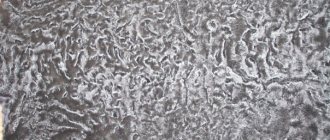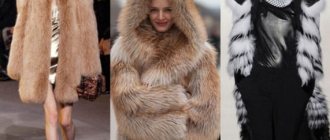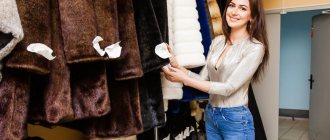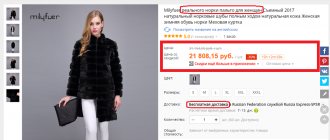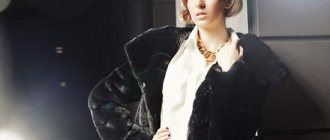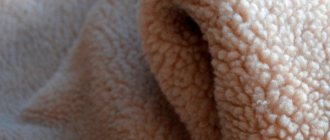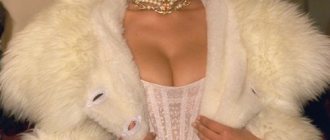When choosing a fur coat, it is simply impossible to remain indifferent to fur products made from astrakhan fur. The astrakhan fur coat is not only very durable and wear-resistant, but also retains heat excellently, thanks to the tightly fitted fur fibers. At the same time, astrakhan fur is a rather thin fur, which makes it easier to cut such products and offers a huge variety of styles and shapes, miraculously slimming and emphasizing the figure of the owner of such a fur coat. In addition, each fur coat made from astrakhan fur has a unique uniqueness; in nature, there are no two completely identical skins, similar in curl patterns, these are like human fingerprints. The question arises - How to choose a fur coat from astrakhan fur?
When did you start sewing astrakhan fur coats? ^
These products received their name kurakulchi from the city in which they first started making them.
Karakol (which means “Black Lake”) is located in Uzbekistan, where sheep have been bred for many centuries.
Of course, livestock farming in the country was carried out not out of pleasure, but out of necessity: sheep provided wool and meat necessary for the inhabitants of a small and rather wild country.
For decades, local residents sewed fur products based on astrakhan fur and astrakhan fur, only over time coming to understand the full value of the product.
Today, these skins are rare and exclusive, the demand for which is really great. Products made from lamb are incredibly soft and light to the touch.
Things made from this material are becoming more and more popular every year, since this piece of goods has its own unique pattern, which has no analogues yet.
However, buyers should be aware of the main difference between these seemingly similar names: broadtail is the fur of premature lambs, and astrakhan fur is those that are already several days old.
Fashionable astrakhan fur coats - which color to choose?
Karakul is the tanned skins of newborn lambs (not older than 7 days) of the Karakul breed.
Astrakhan fur is very short and soft, with small elastic curls in different directions, silky and shiny. Astrakhan fur can be black, white, or brown, but the most common fur is black, the value of which is determined by the uniqueness of the curl pattern and the density of the fur. Selection work on the livestock consisted of breeding sheep of various colors. This is how the gray color appeared, the value of which is rather not in the drawing, but in the play of color, its smooth transition.
What are the advantages of such outerwear? ^
When thinking about buying a very expensive product, it is important to understand that fur coats made from astrakhan fur and astrakhan fur are two different things.
The broadtail is distinguished by its soft and slightly silky fur, thin and dense pile, which forms a stunning cover and intricate pattern.
In turn, astrakhan fur is a material with an even denser and slightly rougher structure. Small curls are initially formed on it, giving a special zest to any product.
Fashion designers and modern women prefer to give their preference to astrakhan fur, since it is the one that looks most harmonious and sophisticated on the human body.
When properly processed, this fur turns into a luxurious and stylish garment that deserves the highest praise.
An astrakhan fur coat has a main feature that no fashionista can pass by: it does not make the owner look fat.
However, in addition to aesthetic satisfaction, these things serve as excellent protection from the harsh winter realities.
According to reviews from happy owners, this piece of clothing retains heat perfectly and is not affected by piercing winds.
Thanks to some features of the material, this type of clothing is as comfortable to wear as it is lightweight and breathable.
On top of everything else, these products are famous for their durability. Owners of fur coats can be sure that they will wear them for at least 7 seasons without encountering any problems.
Quite comparable in price to astrakhan fur, chic-looking beaver coats have one undeniable advantage - they do not get wet. What models and styles there are, read the article about prices for beaver fur coats, be sure of your own irresistibility!
Mink fur coats are more expensive and have already become classics. You can find out how to choose the right one, what they go with, here, we have also selected recommendations on ways to save money when purchasing, we recommend reading the article - perhaps this kind of clothing is your choice?
Also now fur coats made from faux fur are gaining popularity; they are inexpensive, unpretentious, moth-proof, plus they come in the brightest and most varied colors. Do you want to attract attention? Then this is the best choice! A detailed article about such fur coats is here, we recommend that you read it.
How to choose what to pay attention to? ^
Fur coats made from astrakhan fur and astrakhan fur, whose advantages were described above, are presented on the modern market in several colors (black, silver and brown).
However, the most popular color was and remains classic black, suitable for absolutely all women and in harmony with a lot of accessories. Black always looks expensive and stylish, which is why a similar product costs a little more than similar options. However, modern manufacturers have perfectly learned to create expensive fakes.
It is very difficult to distinguish trimmed, dyed and perforated fur from natural fur. Here are just a few tips to help you in the selection process:
- Try shaking the selected product. High-quality material, as a rule, produces a light and unobtrusive rustling sound. If you haven't noticed it, then there's a good chance that the fur is dry.
- When you go shopping, take with you a small piece of any woolen fabric. During the fitting process, lightly rub the fur with it and tug at the fibers. If they fall out, then most likely the material was taken during molting, which, in fact, is generally prohibited.
- Don’t be shy to grab the thing with your hands and press it to you. As soon as you release it, the fur should immediately return to its original form. At the same time, it is important to monitor the condition of the villi, which should not stick together.
- If you see that the fur is frankly dull, then you should not take it. This serves as a signal that it was taken from a sick animal.
- When feeling the product, run your hand not along the pile, but against it. If the fibers you have touched break , and there is no dense fluff behind them, then the product is of poor quality and, most likely, handicraft.
- Blow on the fur and look at its base. Happened? It's a pity. It shouldn't be visible at all. Refuse to purchase such a product if you do not want your purchase to “go bald” in the coming season.
- In order to determine whether the fur is dyed or not, you need to rub it with a white scarf. It certainly shouldn't stain. In this situation, it makes sense to pay attention to even barely noticeable traces, since you can be sure: the very first rain will color all your clothes to match your fur coat.
Also, you need to pay attention to the quality of the entire product, and not just the fur:
- The seams under the collar should be neatly hidden. The collar itself must “stand” confidently and keep its shape;
- the belt included in the kit should match the tone of the product as closely as possible;
- all fasteners must be hidden from prying eyes;
- the hem should be selected at least fifteen centimeters above the ankle (at least if you live in Russia). This way you will increase the life of the product and significantly save on dry cleaning.
Chic and very beautiful, warm fur coats are made from lynx fur. What are their advantages, how to choose the best option, read the article about the prices of lynx fur coats, such clothes are the best way to attract the attention of others!
One of the most expensive types of fur coats in the world is chinchilla. Why they cost so much, what types they come in, what they are combined with - read here, this is a truly chic thing and the best gift from a loved one.
Another type of fur coat, very similar to a chinchilla, but much cheaper, is made from the Rex rabbit. How they look, how much they cost, what they are combined with and where is the best place to buy - read here: https://proodezhdu.ru/womans_clothing/fur-coats/shuby-iz-krolika-reksa.html, you can look attractive for quite affordable money.
How to distinguish genuine astrakhan from a fake
There are a few simple rules that will help the average buyer understand the quality of an astrakhan item. 1. The fur is smooth as silk. When directed to direct light (a flashlight will do), the wool shimmers. 2. Pay attention to the density of curls. Half-opened ones are absolutely not suitable. This means that the skin was taken from the lamb later than 3 days later. Bald patches also indicate poor quality material. 3. Squeeze the product with your hands. If the fur returns to its original shape, the item is genuine. The flesh is white and should not be deformed.
What things go well with and complement such a fur coat? ^
As mentioned earlier: options from astrakhan fur and astrakhan fur come in several shades: golden, silver, black, snow-white and light gray.
It is worth understanding that each of the indicated colors forms a special characteristic pattern, which should be based on when choosing accompanying accessories. Here are just a few rules from famous designers:
- Astrakhan fur goes well with any fur. Don't be afraid to combine clothes with hats and collars from other animals. They are quite expensive (around $500), but they favorably emphasize the status of the owner.
- When choosing shoes, stick to the classic version. High boots of a dark color, medium heels - all these are also elements of success. buy boots made of genuine leather for 7-10 thousand rubles .
- With this material, it is most beneficial to wear skirts rather than trousers. Karakul does not make you look fat, so it allows you to look feminine and light even in winter. A stylish skirt that matches such outerwear can cost around 4 thousand rubles .
- Don't forget to complement your look with leather gloves. They can reach to the elbow (if the sleeve of your purchase is 3/4) or only to the wrist. The cost of good gloves varies from 2 to 5 thousand rubles .
- Try to avoid decorations that can visually distract from the whole picture. If you can’t do without them, then give preference to minimalism, using simple chains, the cost of which rarely exceeds 2-3 thousand rubles .
- Don't forget about the belt, which most often comes with the product. If it is not there, then order the accessory separately, but from the same material. The cost of their karakul belt will reach 5-6 thousand rubles.
Fur coats made from silver fox fur look very beautiful and expensive. How to choose such a fur coat, how much it costs and much more can be read here, we have collected customer reviews, prices, and much more.
Also, marten fur coats have been valued at all times, this is a very warm and pleasant to the touch fur. Read about such fur coats in the article “Marten fur coats - how to choose, prices, reviews”, create your ideal look!
Fur astrakhan fur
The uniqueness of the doodle pattern
Depending on the origin of the sheep and the method of dressing, there are many names for this fur: broadtail, astrakhan fur, yahobab, astragan, lamb, swakara. The name “karakul” or “karakulcha” from the Turkic language means “Black Lake”, after the name of the city and area in Turkestan. Now called Uzbekistan. The homeland of karakul is Central Asia.
Karakulcha is the fur of premature Karakul lambs. It has a thinner, easily stretchable skin and short, shiny fur that fits tightly to the flesh with a moiré pattern, without clearly formed curls. The beauty of broadtail fur is that the curls that have not had time to rise look and feel like velvet.
The main value lies in the beautiful moire “sketch” of the future pattern. Depending on the method of dressing, origin and color of fur, broadtail has many names. “Colored broadtail” comes in black, gray, and brown colors. The most common and valuable color is sur and antique.
Astrakhan material is not very durable, but beautiful and expensive. The cost is equal to the most expensive varieties of astrakhan fur. It has less wear, approximately 2 - 3 seasons, broadtail is not resistant to abrasion and mechanical stress, easily forms creases, and is at the end of the wear resistance table for furs. Astrakhan broadtail is used for making exclusive and fashionable items “for going out”, since its extraordinary lightness and tenderness has a downside: such products are extremely fragile.
Karakul is the fur of Karakul lambs, the skin of which is removed 1-3 days after birth. Leather fabric is thin and soft. Silky, soft, elastic, thick and shiny wool forms curls of different shapes and sizes. Each astrakhan skin is unique, its patterns are unique, like the lines on the palms of a person. The most important element that determines the value of astrakhan sheep is the curls on the skin of the astrakhan sheep, which determine the pattern of its surface. They come in different configurations, sizes, and locations.
If the curls on the skin are folded into rows and then into a pattern, such scribble is considered the most expensive. And the lowest cost is for “curly” skins, on which small curls are scattered chaotically and haphazardly. The longer the wool, the worse the quality of the curls and the less interesting their character, so the value of the skins decreases as the lambs grow. And only if the curls meet the quality requirements and are present in sufficient quantity, other criteria for evaluating the skin come into force, such as the thickness of the fur, its shine, and so on.
Based on the height of the curl, two typical types of karakul are distinguished: – flat type – characterized by lying curls of irregular, broken shape, not closed into a ring. – high type – the curl is located at a right angle to the flesh, the rows of curls look like tubes laid on their sides. The value of high karakul depends on the number and length of such tubes: the more, the better.
The palette of astrakhan is varied - black, gray and its shades, brown. Thanks to new technologies and selection, the choice of color shades is amazing - platinum, steel, gold, amber, beige. The advantage of astrakhan fur is its ability to hold its shape for architectural cut products, and the ability to create an elegant silhouette from it, thanks to its short and smooth pile.
Yahobab - skins of lambs of purebred Karakul sheep under the age of 1 month. It is characterized by overgrown, slightly silky, matte hair and loose elastic curls of various shapes. Used for sewing coats, short coats, hats, collars.
Astragan is a type of specially processed sheepskin fur, one of the highest quality furs, for the production of which modern technologies for processing the highest grade sheepskin are used. Compared to mouton, astragan fur is much lighter, more comfortable and has heat-saving, warming properties. It is superior in quality to Mouton. The astragan product is very wearable. This is explained precisely by the short haircut of the fur, which does not allow the fur to roll down and, accordingly, lose its appearance. Astragan products are elegant and light, practical and comfortable.
Types of the finest karakul
Selection work in different countries involved in the production and export of astrakhan fur was carried out in different directions. Accordingly, the main task of karakul breeders has always been and remains the desire to obtain large batches of identical skins with stable specified characteristics. This is a very difficult job, because the type and quality of astrakhan skin is determined by more than twenty parameters. Plus, capricious fashion dictates a constant change in demand for astrakhan of different types and colors. Today, there are three main types of karakul: Uzbek, Afghan astragan, the most common South African swakara, which is the most expensive type. Astrakhan fur is as durable as sheepskin.
Uzbek karakul was bred by breeders from Uzbekistan, who relied on light and thin jacket-type karakul with a special pattern. On the surface of the skin, tight curls form tubular rolls of different lengths over the entire area of the skin. Uzbek karakul is called “valek”, “bob”, “Moscow jacket”. The size of the skins is on average 11 d². The price of such fur is relatively low and therefore astrakhan fur coats are especially popular.
Afghan karakul - astragan, is distinguished by heavier and larger skins, ranging in size from 12 to 20 d². The type is flatter, characterized by a ribbed-flat curl pattern and extraordinary shine, which gives it a special chicness. Karakul from Afghanistan is very high quality and thick, so it costs more than Uzbek.
The South African karakul "swakara" is characterized by an amazingly clear flat curl, creating a magnificent ribbed pattern formed by clear, tightly rolled, low roller tubes in a parallel arrangement. It has the strength of ordinary astrakhan fur, but its thinness is close to astrakhan fur. The average size is 12-15 d². Swakara is unusually light, wears for a long time, does not require special care and can be used for sewing almost any type and model of fur clothing. Swakara has become a completely new direction in karakul writing. Namibian karakul is the most expensive.
High quality skins of any type are highly valued. The most expensive type of karakul is considered to be swakara. This is due to the excellent results of breeding work and the limited supply of goods supplied to the market. Afghan karakul is the most common and is in great demand. 90% of all gray astrakhan products are made from hides of Afghan origin. The flat, ribbed type is in fashion now and is highly prized, broad tail - the skins of unborn lambs. The valuable fur of the broadtail is distinguished by its low, shiny, silky hairline, adjacent to the skin tissue or just beginning to emerge, with a more or less pronounced moire pattern. The jacket type of karakul, which Uzbekistan specialized in, is considered obsolete.
Swakara is sold at the Copenhagen fur auction Kopenhagen Fur, Afghan karakul, mainly at the Finnish auction in Helsinki Finnish Furs Sales, partly in Copenhagen, Uzbek karakul is represented on the international market in small quantities, it is mainly sold in the domestic market of Uzbekistan.
Palette of shades of the most delicate doodle
Breeding “colored” Karakul sheep has always been an important area of breeding work in producing countries, and impressive results have been achieved along this path. Obtaining colored karakul was one of the areas of breeding work in all countries. Based on hair color, purebred colored karakul are divided into groups:
1. “Sur” or agouti is a hairline that has an uneven distribution of color along the length of the hair: a dark base with a gradual transition to a lighter tip of the hair, forming a zonal coloration of the hairline. The most valuable variety of brown astrakhan fur, it has the following “sur” colors:
a) silver - dark smoky or black hair at the base with a transition to light silver at the ends of the hair; b) golden – dark hair at the base with a transition to golden at the ends of the hair; c) bronze - brown hair of all shades at the base with a gradual transition to light bronze or orange at the ends of the hair; d) amber - brown hair at the base with a gradual transition to amber at the ends of the hair; e) platinum - dark brown or coffee-colored hair at the base with a gradual transition to light cream at the ends of the hair; f) steel (pulat sur) - black hair at the base with a gradual transition to white or steel at the ends of the hair; g) apricot flower (uriukgul) - dark brown or dark orange hair with a gradual transition to a delicate beige-brown color with a bluish tint at the ends of the hair.
2. Plain brown astrakhan fur has hair of uniform brown color in different shades, from dark to light brown. Brown skins are characterized by khalili coloring - brown with black spots or black with brown spots, symmetrically located on the skin, as well as bordering the edges with another hair that differs in color from the main one. Brown astrakhan fur is a rare color and is rarely used in its natural form. This is due to the difficulty of choosing astrakhan fur with identical curls and a wide range of colors: from chocolate to beige, from red to cold fawn.
3. Plain astrakhan of other colors is characterized by hair of all shades of gray and brown, monochromatic coloring, as well as black hair with gray hair, “with frost.”
Gray astrakhan fur is gray hair, consisting of mixed black and white hair in different proportions, forming different shades. The main charm of gray astrakhan is the play of color, which has a less interesting pattern than black astrakhan. Depending on the ratio of black to white hairs, the possible colors of the gray doodle range from light gray-blue to black with a gray stripe along the ridge. Gray astrakhan fur is an excellent material for coloring, as the neutral gray color eliminates color distortions.
At the same time, interesting color transitions are preserved - white hairs are intensely colored, and dark ones are muted. Gray astrakhan was obtained in all producing countries, but particular success was achieved in Afghanistan, where the share of gray astrakhan can reach 60%.
White astrakhan fur is the rarest, with white hair; black spots are allowed on the muzzle, ears and legs. The best results in terms of quality and quantity were achieved only in Namibia. White swakara has an even, clean, milky color. The Afghan White Doodle is a rare random drop of light grey.
4. Variegated astrakhan fur - hair with spots (spots) of a different color than the main color on the remaining area of the skin, exceeding 12 cm², except for the head, tail and legs.
Pink or guligaz is hair of pink shades, from light to dark pink, formed by mixing white and brown hair. If a gray karakul contains a certain amount of brown hairs, the skin takes on a beautiful lilac hue. This variety of karakul is called “guligaz”, translated from Uzbek as “tamarisk flower”.
5. The most common color of astrakhan fur is black, determined by the dominant gene. In black, the unique pattern becomes especially valuable. In Central Asia, black astrakhan fur is treated like a luxurious flower - a “black rose”.
Modern technologies for processing astrakhan fur
Astrakhan fur coloring is widely used in different variants. So, if the skins are used without changing the natural color of the hair, the core is dyed the same color: this allows you to hide the areas where the curls diverge, exposing the base. A similar fur defect often appears on finished products during wear. Another reason for coloring doodles is to achieve design goals; most often they change the color of gray skins by simply dipping them into a solution with dyes. Discoloration is also often used, as a result of which astrakhan (usually with the most beautiful pattern) turns from traditional black to dark beige. The disadvantage of bleaching is the harshness of the process, which “kills” the shine of the fur and its silkiness. There are also more expensive and complex technologies, such as dyeing astrakhan with a stencil, painting or bleaching some areas of the skins while maintaining the natural color in other places. The hide can be processed “suede-like” or like leather, used for double-sided fur items.
Joining astrakhan skins can be done in two ways. The first - the so-called "shovel" assembly - is the simplest, least expensive and fastest; in this case, the largest possible size rectangular or trapezoidal pieces are simply cut from the skins, which are subsequently sewn together. The second is used when processing expensive high-quality scribble: the connecting line in this case has a complex shape, since it bypasses the curls, but the result is a solid canvas without visual signs of joints.
In Russia, astrakhan fur is difficult to consider as winter fur, since thermal comfort in astrakhan fur is felt at external temperatures not lower than -10 degrees, but it is quite suitable for mild European winters. However, winter clothes made from astrakhan fur are in high demand among domestic fashionistas: firstly, this fur hides the fullness of the figure (not all women can boast of “model” shapes 90-60-90!) Secondly, it looks ideal with voluminous figures fur trim, and collars made of long fur are very relevant for Russia.
Karakul is a historical fur that has passed through centuries
The history of karakul goes back thousands of years, because sheep breeding is one of the oldest human occupations. Karakul sheep, which perfectly adapt to the semi-desert climate, have become widespread in the Middle East and northern Africa, including Namibia. Local specialization was aimed at breeding sheep with fur with tight, low, clear curls, folding into long, parallel oriented rolls.
Karakul sheep are the first type of domestic animal that began to be bred for its beautiful fur. This breed of sheep has gained immense popularity among the population of Central Asia, precisely because of its unpretentiousness and excellent adaptability to semi-desert conditions. Presumably the history of the Karakul sheep began in the 8th century in the Khorezm Khanate in Bukhara, now Uzbekistan. The ancestor of the current sheep is considered to be the Uzbek Karakul sheep.
In the 10th century, the Arab geographer and traveler Ibn-Haukal documented in writing the trade in astrakhan skins. In the 13th century, the famous traveler Marco Polo enthusiastically described karakul patterns in his notes about Central Asia. In the 15th century, karakul skin from Bukhara was brought to Rus' by the famous Russian writer and traveler from Tver, Afanasy Nikitin. In the Middle Ages until the 16th century, Bukhara merchants transported luxurious soft astrakhan skins on camels along the Great Silk Road from Asia to the Mediterranean, from where they were distributed throughout Europe. Merchants of the Bukhara Emirate sold astrakhan and broadtail in the markets of Germany, Italy, Greece, and Scandinavian countries.
In the 17th-18th centuries, merchants from Bukhara and Khiva supplied magnificent astrakhan skins to Russia. Traders offered lamb skins at the Moscow, Tobolsk and Tver markets, in Nizhny Novgorod and Irbit. In the 19th century, astrakhan fur occupied a special place at international fur auctions in New York, Leipzig, and London and was extremely popular among buyers. Until the beginning of the 20th century in 1900, the khanates of Central Asia, and later Russia, had a monopoly on the supply of karakul on the world market. Great interest in Karakul contributed to the breeding of Karakul sheep at a scientific level in Europe - in agricultural institutes in Germany and Austria.
In 1907, a batch of Karakul sheep was imported from Bukhara to Austria, 6 individuals were transported to the southwest of the African continent. Thus began the history of the development of a completely new direction in karakul-making - Namibian karakul or “svakara”. Swakara is an abbreviation of the name of the famous South African brand South-West Africa Karakul. In the 10s of the 20th century, the bulk of Karakul sheep, numbering about two million, were still located on Central Asian territory, being the property of the Bukhara emir. In 1917, with the establishment of Soviet power in Uzbekistan, the number of sheep decreased greatly. During the struggle between the bais and the “new government,” not only people, but also animals suffered. The herds were partially exterminated, 70,000 animals were driven to Iran, about 400,000 sheep were transported by landowners to Afghanistan, which marked the beginning of the Afghan karakul. In each of these countries, astrakhan culture followed its own path, which led to the creation of three types of astrakhan, similar to each other, but not identical: Uzbek, Afghan and South African astrakhan.
The newly formed Central Asian Soviet republics made the breeding of Karakul sheep the main article of the state economy, creating state farms, collective farms and breeding farms for this purpose. Many research institutes of the USSR dealt with the issues of karakul breeding. The Soviet Union was positioned as the largest producer and exporter of astrakhan skins. By the second half of the 20th century, there were about 700 enterprises in the karakul industry in the country. The sale of karakul, which accounted for 40% of fur exports, took place at the Leningrad Soyuzfur auctions, where the BUHARA KARAKUL brand was in constant high demand.
The heyday of karakul farming was noted in the 70-80s of the 20th century. At this time, up to 18 million skins were produced in the world, the lion's share of which, up to 95%, came to the market from Namibia, Afghanistan and the Soviet Union. Following the heyday, a crisis broke out, which was based on political events in the karakul-producing countries. At first, the export of skins from Afghanistan almost stopped due to ongoing military operations. Then the Soviet Union collapsed, the former republics in Central Asia became independent states. Independence did not lead to anything good: left without centralized control, the management of the karakul farming farms began to enrich themselves, promptly selling all available skins, including destroying purebred breeding sheep that were supposed to continue the breed. Breeding research stopped, records were no longer kept at breeding farms, and professionals in the field of karakul breeding became unemployed. The huge amount of karakul accumulated in the Central Asian part of the USSR was almost entirely imported to Europe, mostly to Germany, famous for its processing enterprises. Prices for astrakhan fur on the world market began to fall rapidly.
Thus, astrakhan fur has lost its status as an elite fur and popularity among buyers. This was facilitated by the fact that the small batches of skins that occasionally entered the market were of very low quality - after all, breeding work was not carried out. Following the changes in the political situation, world psychology began to change: environmentalists became more active, including those advocating for animal rights, the fashion for fur products was replaced by the propaganda of artificial materials. As a result, the global volume of karakul sold decreased by 20 times. Now the international market for astrakhan skins is characterized by the following figures: it represents about 150,000 swakara skins, about 400,000 Afghan types of astrakhan, approximately 50,000 Uzbek ones. According to some reports, about half a million more skins are sold in Uzbekistan, within the domestic market.
Triumph of the noble doodle
Karakul came into fashion at the end of the 19th century. An expensive and prestigious astrakhan fur coat, black or gray, could only be worn by the wives of high-ranking government officials and the political elite. This gave rigor and pomp to products made from astrakhan fur and astrakhan fur. A fur coat of a classic silhouette, made of black or gray astrakhan fur, was a very stylish and precious item in the wardrobe. Karakul achieved particular popularity; it was used to sew clothes, collars and cuffs for coats, hats and caps, and was used in decoration and for making accessories. At the beginning of the 20th century, children's fur coats were made from astrakhan fur, which were decorated with decorative braid and embroidery. The dream of little fashionable ladies was a white astrakhan fur coat with a muff. For adult fashionistas, an egg-shaped coat with a fox collar was made. During the war years of the 40s, astrakhan fur was in great demand, which was reflected in the shortage of assortment.
The 80s brought floor-length astrakhan fur coats, jackets and ponchos back into fashion. Astrakhan fur ceased to be associated with the age category of women of “Balzac age”, and confidently gained popularity among young people. In the early 90s, Ralph Lauren played with karakul in the folk spirit, presenting kubanka hats and Hungarian hussar caps made of karakul, decorated with cords. A hit in the winter of 1998-1999. became handbags made of colored astrakhan fur from Chanel and pink slippers from Dolce&Gabbana. Tom Ford for Gucci last season offered the finest tops made of walnut and olive broadtail. And this winter you could see broadtail of all colors on the catwalks. In recent decades, fur coats made from the finest astrakhan fur and astrakhan fur have not gone out of fashion, thanks to the latest design solutions that have breathed new life into them.
The revival of karakul as a popular fur occurred in 2004, when in Milan, at the spring show, fashion designers of the famous house Prada included in the collection a headdress made of Namibian karakul (black swakara) - the “pie”, so beloved by Soviet party leaders. The formula “new is just forgotten old” once again worked perfectly, and karakul, which many fashion trendsetters hastened to declare hopelessly outdated, found a second life. In addition to the interesting texture of the fur, the doodle is also benefited by its current rarity on the market - an indispensable condition for the material from which unique, exclusive products are sewn.
In 2005, karakul triumphantly walked the most prestigious catwalks in the world; it was used in the creation of their collections by the most famous Fashion Houses: Prada and Gucci, Dolce & Gabbana and Valentino, J. Mendel and Michael Kors, Jean Paul Gaultier and Roberto Cavalli, Missoni and Louis Vuitton . Delicate fur with an elegant, sophisticated pattern has once again risen to the peak of world fashion - and the price of astrakhan fur on the world market, always sensitive to fashion trends, has quadrupled in just three years.
Practicality of astrakhan fur, astrakhan fur and swakara
Swakara, astrakhan fur and the finest broadtail have not left the catwalks, the pages of fashion magazines and the hearts of lovers of fur and beauty for many years. Modern fashion trends have made karakul sparkle with new colors. The color range is extensive and amazing in its diversity, thanks to new processing technologies and fur dyeing. The fur of astrakhan and astrakhan fur has acquired completely new colors and shades, from amber-golden to bluish-steel, from classic black to unusual bright colors. This allows you to use astrakhan fur in various collections of famous designers, using non-standard solutions in cutting, and significantly expanding the scope of its application in the manufacture of various types of products.
The style of products made from astrakhan fur and astrakhan fur has become more daring and stylish, designed for the younger generation. Products made from astrakhan fur or astrakhan fur are incredibly beautiful, wonderful, relevant, have an original appearance, unique patterns created by unique curls.
The finest broadtail, in combination with other natural materials, is used in the manufacture of various models of clothing, which looks incomparable and gives the products a special chic. The boldness of the design idea gave rise to the most incredible, but amazingly beautiful and bright combinations of astrakhan fur with lynx or badger fur, crocodile skin, and bird feathers. Today, astrakhan fur, which has triumphantly returned to the podium of popularity after undeserved oblivion, is not just a material for sewing comfortable and practical things, but an indispensable attribute of super-fashionable wardrobes and a sign of true luxury.
Astrakhan fur is used for sewing outerwear, suits, hats, and accessories. Narrow astrakhan coats of the “glamor” type, stoles, dresses, bags and shoes are very impressive - they combine the simplicity and luxury of astrakhan, astrakhan fur and swakara. An exquisite fur coat made from astrakhan fur or astrakhan fur is light, thin, warm, pleasant to the touch, does not make you fat, and comfortable to wear. Men's clothing is also made from astrakhan fur - classic jackets and sports jackets look stylish and elegant.
Where is the best place to buy? ^
A number of companies are involved in the production of such things, each of which deserves review and special attention.
However, within the framework of the article, we can only name 5 names of manufacturing companies whose products are worth taking a closer look at. These are: SAGITTA, Karolina, Manakas, Aleph and Radena.
Prices for products in them, as a rule, reach impressive levels. We see many examples where a piece of clothing outweighs a car, an apartment, or a country house.
However, they rarely regret such purchases, and leave them only in dreams - even less often.
In the modern fashion market, the price of a full-fledged broadtail fur coat varies from forty to eighty thousand rubles.
However, it is worth understanding that the price depends on the point of sale and the ambitions of the entrepreneur.
That is why it makes sense to place orders in online stores, where the quality of the goods is no lower, and the cost is several times lower.
Dear visitors!
If you know how to count money and regularly buy things on the Internet, then we recommend reading our article about how you can return part of the money spent on a purchase using so-called cashback services.
We have selected the 3 best options, you can return up to 30-40% of the cost of an item purchased online (clothes, bags, shoes, whatever)!
So, read our article “Top 3 cashback (money back) services when buying clothes and accessories in online stores” and save your money, because money saved is money earned.
We also recommend that you read our article about the 3 best online stores for buying mink coats; you can save a lot of money when purchasing without sacrificing the quality of the item, especially since now it’s sales time!
Low price tags are due to the absence of the need to rent premises and hire service personnel.
All funds allocated by the company most often go towards creating more attractive offers for customers and organizing promotions, during which the desired goods become even more accessible.
There are plenty of advantages to shopping online, but the convenience of placing orders is worth highlighting. In just a few clicks of the mouse, you can arrange a parcel to any city in the Russian Federation, without exposing yourself to any risk.
The Internet does not deprive shopping lovers of their pleasure. On the contrary, the opportunity to go shopping and feel the model you like with your own hands is priceless.
Once you are sure that the product really fits your figure, you can safely order it online and wait for the courier.
The cost will seem prohibitive to many. However, it is completely justified.
For those who want to save money, but at the same time do not want to give up their dreams, it makes sense to pay attention not to solid products, but to those sewn from pieces. They usually cost almost thirty percent less.
SHARE Facebook
- tweet
Previous articleAll about fur coats made from Rex rabbit fur
Next articleChic and luxury - all about beaver coats, their cost, suitable accessories
admin2014
SIMILAR ARTICLESMORE FROM THE AUTHOR
TOP 7 winter coats with a hood 2019
TOP-7 cross-cut mink coats 2021 from $1000 to $2000 (60-120 thousand rubles)
Sale of mink coats: a scam or a real way to save?
Where is the best place in Moscow to buy a high-quality inexpensive mink coat?
Buying a fox fur coat: how much it costs, what it goes with and how to save money when buying
Marten fur coat: how much it costs, how to choose, what it goes with
